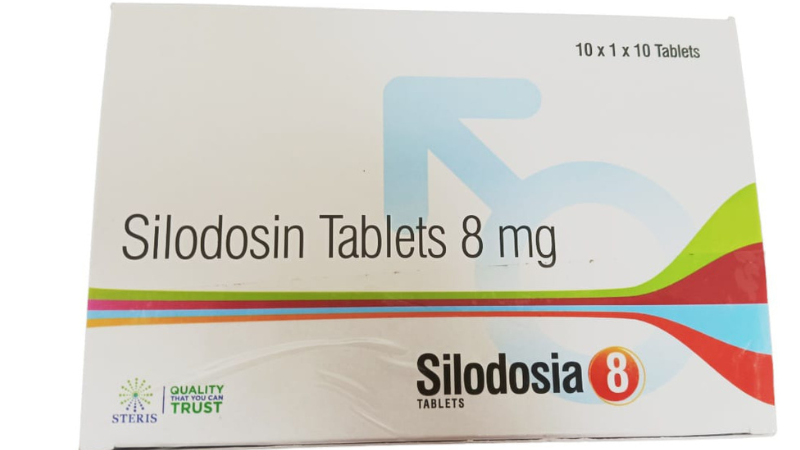Silodosin: Its Uses, Interactions, and Mechanism of Action - Insights from DrugBank.
Mar 29, 2024
Silodosin, a medication primarily prescribed for the treatment of benign prostatic hyperplasia (BPH), holds significant therapeutic value in managing lower urinary tract symptoms (LUTS) associated with this condition. It belongs to the class of drugs known as selective alpha-1 blockers, exerting its effects on the smooth muscle cells of the prostate gland and bladder neck. In this article, we delve into the comprehensive understanding of Silodosin, exploring its uses, interactions, and mechanism of action, drawing insights from the pharmaceutical database DrugBank.
Uses of Silodosin:
Silodosin is primarily indicated for the treatment of BPH, a common condition affecting aging males characterized by enlargement of the prostate gland, leading to urinary symptoms such as frequent urination, urgency, weak urine flow, and incomplete bladder emptying. By antagonizing alpha-1 adrenergic receptors in the prostate gland and bladder neck, Silodosin effectively relaxes smooth muscle tone, thereby improving urinary flow and reducing symptoms associated with BPH. Additionally, Silodosin has been investigated for its potential efficacy in the management of chronic prostatitis/chronic pelvic pain syndrome (CP/CPPS), although its use for this indication is off-label and requires further clinical validation.
Mechanism of Action:
Silodosin exerts its pharmacological effects through selective antagonism of alpha-1 adrenergic receptors, particularly the alpha-1A subtype, which is predominant in the prostate gland and bladder neck. Alpha-1 receptors are part of the sympathetic nervous system and are involved in the regulation of smooth muscle tone in various organs, including the prostate and urinary bladder. By blocking these receptors, Silodosin inhibits the vasoconstrictive effects of norepinephrine and relaxes smooth muscle fibers in the prostate gland and bladder neck, leading to improved urinary flow and symptom relief in patients with BPH.
Interactions of Silodosin:
Understanding potential drug interactions is crucial to ensuring the safe and effective use of Silodosin in clinical practice. According to DrugBank, Silodosin may interact with several medications, including other alpha-1 blockers, antihypertensive agents, and drugs metabolized by the cytochrome P450 (CYP) enzyme system. Concurrent use of Silodosin with other alpha-1 blockers such as doxazosin or tamsulosin may potentiate hypotensive effects and increase the risk of orthostatic hypotension, necessitating dose adjustments and close monitoring of blood pressure. Additionally, concomitant administration of Silodosin with antihypertensive drugs like diuretics or calcium channel blockers may further lower blood pressure, requiring dosage modifications to prevent excessive hypotension.
Moreover, Silodosin is primarily metabolized by the CYP3A4 enzyme system in the liver, and coadministration with potent inhibitors or inducers of CYP3A4 may alter its plasma concentration and pharmacodynamic effects. Drugs such as ketoconazole, clarithromycin, and ritonavir, known CYP3A4 inhibitors, can increase Silodosin levels, potentially leading to enhanced pharmacological effects and an increased risk of adverse reactions. On the contrary, CYP3A4 inducers like rifampin or St. John's wort may reduce Silodosin levels, compromising its therapeutic efficacy and necessitating dosage adjustments or alternative treatment options.
It is essential for healthcare professionals to assess potential drug interactions and consider dose adjustments or alternative therapies when prescribing Silodosin concomitantly with other medications to optimize patient safety and therapeutic outcomes.
Conclusion:
Silodosin represents a valuable therapeutic option for the management of BPH and associated lower urinary tract symptoms, offering selective alpha-1 blockade and smooth muscle relaxation in the prostate gland and bladder neck. Understanding its mechanism of action and potential drug interactions is crucial for safe and effective clinical use. DrugBank provides comprehensive insights into the pharmacological profile of Silodosin, aiding healthcare professionals in optimizing treatment regimens and minimizing the risk of adverse effects. Through careful consideration of its uses, interactions, and mechanism of action, Silodosin continues to play a pivotal role in enhancing the quality of life for patients affected by benign prostatic hyperplasia. A team of highly skilled professionals in the pharmaceutical field established Steris Healthcare Pvt Ltd in February 2018. Sterispharma is a certified pharmaceutical company by WHO, GMP, and ISO, situated in Navi Mumbai. It is dedicated to delivering high-quality medications at competitive prices to customers across India, adhering to WHO's stringent standards. Through Steris's online pharmacy, customers can conveniently purchase medicines and receive home delivery. Our primary objective at Steris is to offer a comprehensive range of healthcare products to fulfill the diverse requirements of the healthcare industry. Steris is committed to meeting the healthcare sector's demands, whether it's specialized treatments, medications for rare diseases, or essential pharmaceuticals. The range of Steris healthcare products caters to various medical needs, including Cardiology, Asthma, Respiratory, Nasal, Diabetes, Endocrinology, Gastrology, Orthopedics, Anti-infective/antibiotics,General Medicine, Urology, Neurology, Nephrology, Oncology, Gynecology, Pediatrics, Dental, and Dermatology.For further information: EMAIL: info@sterispharma.com / contact@sterispharma.com CALL/WHATSAPP:: 7877551268, 8209542042, 8955945010, 6377716668 BUY NOW
Recent Post

Ursodeoxycholic Acid Tablets – Effective Treatment for Liver & Gallbladder Health

Thiamine Hydrochloride, Riboflavin and Pyridoxine Hydrochloride Tablets

Avanafil 100 mg Tablet – Effective Treatment for Erectile Dysfunction | Steris Healthcare

Atrovastatin Calcium and Ezetimibe IP 20/10mg – Heart & Cholesterol Care

Atorvastatin 10 mg & Ezetimibe 10 mg Tablet – Cholesterol Control & Heart Health

Atorvastatin 10 mg + Vitamin D3 Tablets

Amlodipine 5mg tablet : Best Medicine for High Blood Pressure

L-Glutathione Tablets – Advanced Skin Brightening & Antioxidant Support

Microscopic Atomize Burn: Understanding the Invisible Damage Beneath the Skin

Steris Ultra Gel: The Perfect Partner for Smooth & Accurate Ultrasound Scans

